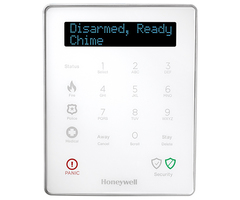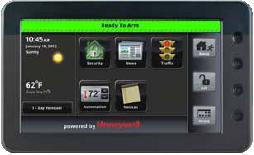Alarm Grid Proud to Offer Two New PowerG Keypads
Posted By Julia RossAlarm Grid offers the latest wireless keypads, compatible with IQ4 and IQ Pro panels. The Qolsys IQ Keypad-PG is a simple capacitive touch keypad, while the Qolsys IQ Keypad Prox-PG adds a prox tag reader for easy use. Both keypads offer PowerG's impressive range for reliable communication.
Below is the IQ Keypad Prox-PG. The bullseye symbol in the lower right denotes the proximity reader:

As wonderful as a big, beautiful touchscreen interface is, sometimes you just need to arm or disarm the system and don't want to walk to the panel to do it. Maybe you're entering or exiting through a seldom-used basement door or planning to hang out in the garage when you arrive home. A secondary arming and disarming station can come in handy, for a wide variety of reasons.
Enter the two (2) new PowerG keypads available from Qolsys. The Qolsys IQ Keypad-PG is a basic wireless keypad that allows you to disarm by entering a valid code through the number pad. It has icons for single-touch Night, Away, and Stay arming when secure arming is disabled. When secure arming is enabled, arm using any valid user code.
If you can arm through the touchscreen without entering a code, then Secure Arming is disabled. You can change this setting by tapping the gray menu bar at the top of the screen, above the date and time, then tapping Settings > Advanced Settings > Enter Installer or Dealer Code (1111 or 2222 respectively, by default) > Installation > Security & Arming > Secure Arming. This feature is disabled by default. That means, by default, you can arm the system without entering a valid code.
When we talk about the IQ4 panels, we're talking about the IQ Panel 4, the Qolsys flagship, top-of-the-line, feature-rich touchscreen panel. Also included is the IQ4 Hub, another touchscreen panel with a slightly trimmed-down feature set. And finally, the IQ4 NS rounds out this panel lineup. The IQ4 NS is a budget-friendly option with nearly identical features as the IQ4 Hub, minus the touchscreen interface. All these panels support the IQ Keypad-PG and the IQ Keypad Prox-PG and prox tag arming/disarming. Just be sure the panel has the latest firmware.
IQ Keypad-PG
The IQ Keypad-PG is a stylish capacitive-touch numerical keypad. It has PowerG wireless transmitting capability and offers superior range, military-grade, 128-bit AES encryption, and bi-directional communication with the panel. Four (4) AA batteries are used to power the unit. Only Energizer AA 1.5 Volt Alkaline batteries should be used. The expected battery life is three (3) years. Each alarm system can support up to five (5) keypads.
IQ Keypad Prox-PG
The IQ Keypad Prox-PG has the same features and specifications as the IQ Keypad-PG, with one exception. It supports prox tags. If you're unfamiliar with prox tags, they're small, hand-held devices that allow you to easily arm and disarm the system by presenting the tag to the keypad in the designated space. When you present your valid tag to the keypad while the system is armed, it will toggle the system to a disarmed state. If you present your tag to the keypad when the system is disarmed, it will attempt to arm the system.
Prox tags come in packs of four (4). The included clip allows them to connect easily to a key ring:

If Force Arm is enabled when you present your prox tag to arm the system, any faulted zones will automatically be bypassed and then the system will arm. If Force Arm is disabled the system will refuse to arm until all zones are restored and the prox tag is presented again. Also, when you present a prox tag to the keypad while the system is disarmed, it will first attempt to arm Stay, then if you present the tag again, it will arm Away.
You can verify the Force Arm setting by tapping the gray menu bar at the top of the screen, above the time and date. Then tap Settings > Advanced Settings > Enter Installer or Dealer Code (1111 or 2222 respectively, by default) > Installation > Security & Arming > Force Arm. This feature is enabled by default. That means, if you attempt to arm and any zones are open or faulted, they will automatically be bypassed so the system can arm.
Specifications:
- Models: IQ Keypad-PG, IQ Keypad Prox-PG (4 Prox Tags Included)
- Interface: Capacitive touch keypad (0-9, *, #, Arm Stay, Arm Away, Arm Night options)
- Available Frequency: PowerG 912 - 919 MHz
- Status Indicator: Status LEDs (Trouble, Arming, Status)
- Sounder: One (1) for key presses, chirps, and alarms.
- Tamper: Yes, Wall and Enclosure Tamper.
- Power Source: 4 x AA – Use only Energizer AA 1.5V Alkaline Batteries.
- Dimensions (H x W x D): 6.1” x 4.6” x .91” (155mm x 117mm x 23mm)
- Mounting Options: Back plate, wall mount only.
- UL/cUL/ULC Certification: UL/cUL Residential Fire and Burglary and UL/ULC Commercial Burglary Alarm Control Unit. Compliant with standards: UL985, UL1023, UL2610, ULC-S545, ULC-S304.
- FCC/IC Certification: FCC ID: 2AAJXQS-IQKP IC: 11205A-QSIQKP.
- Operating Temperature: 14°F - 131°F (-10°C - +55°C) With up to 93% relative humidity, indoor, dry, climate-controlled use only (*)
*UL has only verified operation in 32°F - 120.2°F (0°C - +49°C) and 93% Relative Humidity.





